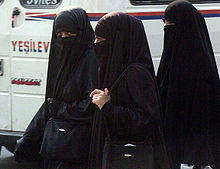Çarşaf

Çarşaf ( Ottoman چارشف; pronounced “Tscharschaf”) is the Turkish form of total veiling with a niqab and is similar to the Iranian chador . Literally translated, Çarşaf means "bed sheet".
The Çarşaf is usually black. As with the Iranian chador, in Çarşaf the lower part of the face is usually covered by holding the cloth under the nose with a pin . Sometimes the cloth covering the lower part of the face is also pinned to the side, as shown here. In contrast to the chador, the Çarşaf usually consists of two parts, an upper part that hangs down over the waist and a lower part that is cut like a wide, floor-length skirt.
The çarşaf is not a traditional Islamic women's clothing, he came only towards the end of the 19th century during the reign of Abdulhamid II. (1876-1908) to fight off to Western influences, and sat down from there, especially in remote areas of the former Ottoman Empire as Yemen , where it is still common today. Traditional Islamic women's clothing in the Ottoman Empire was not as strict as the Çarşaf.
According to surveys in Turkey, only 1.1% of women wore the Çarşaf in 2006 (city: 0.6%; country: 2.2%), in 1999 it was 3.4 percent (city: 2.3% ; Land: 5.9%).
See also
- Veil , there also specifically the section "Islam"
- Headscarf , there also specifically the section "Islam"
- Abaya
- Burqa
- Burkini
- Jilbab
- Hijabista
- Headscarf dispute
- Niqab
- Parda
- Pardösü
- Shayla
- Chador
- Ban on concealment
- World Hijab Day
Individual evidence
- ↑ Ali Çarkoğlu, Binnaz Toprak: Religion, society and politics in a changing Turkey. (pdf, 2.8 MB) Translated by Çiğdem Aksoy Fromm. TESEV publications, Karaköy, Istanbul, ISBN 978-975-8112-90-6 , 2007, p. 63 , archived from the original on October 17, 2013 ; accessed on March 6, 2017 (English).